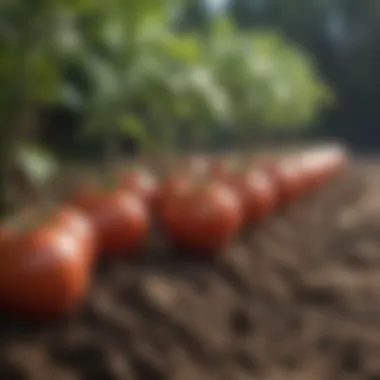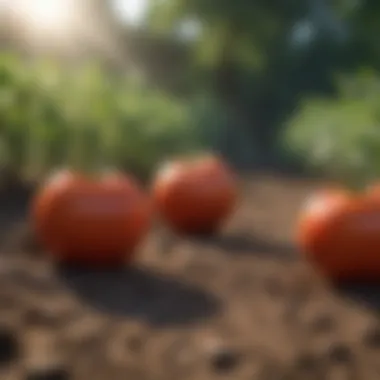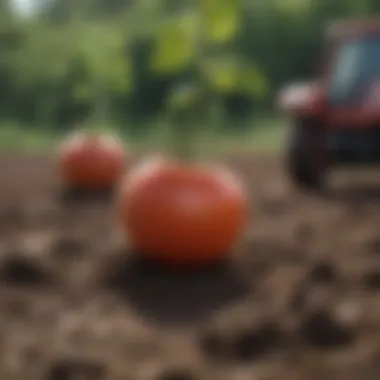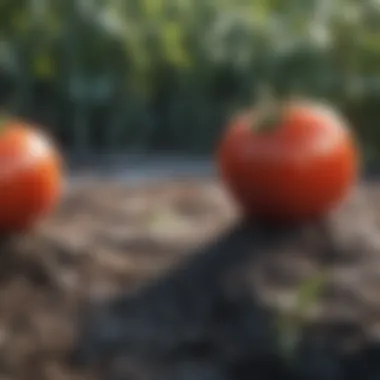Unlocking the Ideal Timing for Planting Tomato Plants Outdoors


Planting Timeline for Optimal Tomato Growth
Introduction
Factors Influencing Planting Timing
Local Climate Conditions
The first crucial factor to consider when planning the outdoor planting of tomato plants is the local climate conditions. The ambient temperature, humidity levels, and precipitation patterns of the region play a pivotal role in the germination and growth of tomato seeds. By studying weather trends and historical data, gardeners can make informed decisions about the most favorable time to initiate the planting process.
Soil Temperature Dynamics
In addition to climate conditions, monitoring soil temperature dynamics is essential for successful tomato cultivation. Tomatoes are particularly sensitive to fluctuations in soil temperature, requiring a consistent and optimal range for robust root development and nutrient absorption. Utilizing soil thermometers and gauging the impact of sunlight exposure can aid in identifying the prime period for planting tomato seeds into outdoor beds.
Critical Frost Dates
One of the primary challenges faced by tomato growers is the threat of frost, which can devastate tender plants in early developmental stages. Understanding the critical frost dates in the local area is indispensable for safeguarding tomato seedlings from chilling temperatures. By aligning planting schedules with post-frost timelines, gardeners can shield their crops from potential cold snaps and ensure a bountiful harvest.
Strategic Planting Calendar
Crafting a strategic planting calendar serves as a proactive approach to optimizing tomato growth and productivity. By integrating insights on local climate conditions, soil temperature dynamics, and critical frost dates, individuals can map out a cohesive timeline for planting tomato plants outdoors. This structured approach not only mitigates risks associated with adverse weather phenomena but also sets the stage for healthy plant development and abundant fruit production.
Reflecting on Optimal Timing
Understanding Tomato Plant Growth Cycle
Tomato plant growth cycle is a fundamental aspect when delving into the world of planting tomato plants outdoors. In this intricate process, each stage plays a crucial role in the eventual success of your tomato cultivation. Understanding the growth cycle provides a road map for optimal planting timing, care practices, and harvesting strategies. By comprehending the nuanced details of germination, seedling development, and maturity stages, growers can anticipate challenges, maximize growth potential, and ensure a bountiful tomato harvest.
Germination Stage
Seed Preparation
Seed preparation is a pivotal step in the germination stage of tomato plants' growth cycle. The meticulous process of selecting high-quality seeds and preparing them sets the foundation for strong and healthy plant development. Proper seed preparation involves assessing seed viability, selecting viable seeds, and utilizing techniques to enhance germination rates. By priming seeds through scarification or soaking, growers can expedite germination and achieve uniform seedling emergence.
Germination Process
The germination process marks the inception of a tomato plant's growth journey. It involves seeds absorbing moisture, initiating metabolic activities, and sprouting into seedlings. During germination, seeds undergo biochemical changes, breaking dormancy, and gearing up for vigorous growth. Adequate moisture, temperature, and oxygen availability are key factors influencing germination success. By understanding the intricacies of the germination process, growers can troubleshoot issues, optimize conditions, and foster robust seedling establishment.


Seedling Stage
Indoor Seed Starting
Indoor seed starting enables growers to kickstart their tomato plant cultivation ahead of the outdoor planting season. By sowing seeds indoors early, individuals gain a head start on plant growth, extend the growing season, and safeguard against unpredictable weather conditions. Indoor environments provide controlled settings for seeds to germinate, develop sturdy stems, and acclimate to sunlight gradually. This technique empowers growers to nurture healthy seedlings, mitigate transplant shock, and enhance overall plant vigor for successful outdoor transplantation.
Transplanting Seedlings
Transplanting seedlings is a critical phase in transitioning young tomato plants from indoor environments to outdoor garden beds. This process requires careful handling to prevent root damage, exposure to environmental stresses, and ensure seamless acclimatization. Gradual hardening off of seedlings prepares them for the rigors of outdoor conditions, minimizing transplant shock and promoting robust root establishment. By mastering the art of transplanting seedlings, growers set the stage for thriving tomato plants that can withstand outdoor challenges and flourish during the growing season.
Maturity and Fruit Development Stage
Flower Formation
Flower formation signifies a pivotal stage in the tomato plant's maturity and fruit development cycle. It heralds the transition from vegetative growth to reproductive success, culminating in the production of floral structures essential for fruit set. Optimal environmental conditions, including adequate sunlight, temperature, and pollination dynamics, influence successful flower formation. Understanding the intricacies of flower physiology, pollination mechanisms, and floral transition stages equips growers with the knowledge to support prolific flower production and enhance fruit yield.
Fruit Setting
Fruit setting is a crucial phase where fertilized flowers transform into developing fruits, setting the stage for a bountiful harvest. This stage demands meticulous attention to environmental conditions, nutrient availability, and proper pollination practices to ensure fruit set and retention. Factors such as proper pruning, pest control, and disease management play a vital role in supporting healthy fruit development. By fostering optimal fruit setting conditions, growers can maximize fruit yield, enhance fruit quality, and celebrate a successful tomato cultivation journey.
Factors Influencing Outdoor Planting Time
Local Climate Conditions
Temperature Requirements
Temperature requirements play a pivotal role in the outdoor planting time conundrum. The intricate dance between temperature fluctuations and tomato plant development unveils a crucial aspect of cultivation. Diving deeper into the nuances of temperature requirements sheds light on the optimal conditions necessary for robust growth. By strategically navigating these requirements, gardeners set the stage for a bountiful tomato harvest. Recognizing the impact of temperature on plant vitality underscores the significance of this factor in the overall cultivation narrative.
Rainfall Patterns
Rainfall patterns add another layer of complexity to the tapestry of outdoor planting time considerations. The oscillation between precipitation levels and plant hydration underscores the delicate balance required for optimal growth. Examining rainfall patterns in detail reveals the strategic role they play in sustaining tomato plants throughout their development stages. A nuanced understanding of how rainfall patterns influence outdoor planting time equips gardeners with the knowledge to cater to their plants' moisture needs. Harnessing the power of rainfall patterns is essential in cultivating a resilient and flourishing tomato garden.
Soil Preparation and Temperature
Testing Soil Temperature
Testing soil temperature emerges as a critical aspect of the outdoor planting time equation. The ability to assess the soil's temperature profile ensures that tomato plants are introduced to an environment conducive to their growth. Understanding the significance of testing soil temperature elucidates the importance of this preparatory step. By employing precise methods to gauge soil temperature, gardeners set a solid foundation for successful plant establishment. The thermal landscape of the soil embodies a key determinant in the intricate dance of outdoor planting time considerations.


Optimal Soil Conditions
Optimal soil conditions serve as the cornerstone for robust plant development. The meticulous attention to creating an environment where soil quality is at its peak sets the stage for tomato plants to flourish. Exploring the nuances of optimal soil conditions unveils the importance of nutrient-rich earth for sustained growth. Delving into the unique features of soil optimization highlights the advantages that lie in providing tomatoes with a fertile substrate for their roots. Nurturing optimal soil conditions is a fundamental step in ensuring the prosperity of tomato plants in the outdoor environment.
Frost Dates and Risk Assessment
Defining Last Spring Frost
Defining the last spring frost marks a crucial milestone in the timeline of outdoor planting time. The ability to pinpoint this event with precision empowers gardeners to navigate the transitional period effectively. Unpacking the key characteristics of the last spring frost sheds light on its significance in mitigating risks to plant health. Understanding the unique features of this environmental occurrence equips individuals with the knowledge to shield their tomato plants from potential harm. The art of defining the last spring frost enriches the outdoor planting time narrative with a layer of preparedness and foresight.
Mitigating Frost Risks
Mitigating frost risks stands as a paramount consideration in the outdoor planting time deliberation. The proactive measures taken to safeguard tomato plants from frost-induced damage speak volumes about the gardener's dedication to their craft. Embracing the key characteristic of mitigating frost risks showcases a commitment to ensuring plant resilience in the face of climatic challenges. Mitigation strategies, when implemented effectively, act as a shield against the adversities posed by frost, preserving the health and vigor of tomato plants. The art of mitigating frost risks is an indispensable facet of the outdoor planting time puzzle, elevating it from a mere task to a strategic endeavor.
Determining the Planting Date
In the realm of cultivating tomato plants, one pivotal step reigns supreme - determining the optimal planting date. This defining moment can dictate the success or failure of your harvest, making it a cornerstone in the journey of tomato cultivation. By honing in on the ideal planting date, you are essentially aligning with nature's rhythm, setting the stage for robust growth and bountiful yields. The significance of this decision extends beyond mere timing; it encompasses a strategic approach to leveraging environmental factors for maximum plant health and productivity.
Using Local Frost Dates as Reference
Consulting Frost Date Charts
Embarking on the quest of consulting frost date charts opens a realm of precise data crucial for your planting deliberations. These charts encapsulate historical frost patterns, offering invaluable insights into the average dates of last spring freezes in your region. By immersing yourself in this data trove, you empower yourself to make informed decisions that mitigate the risks posed by untimely frosts. The beauty of frost date charts lies in their ability to serve as a beacon of guidance, steering your planting schedule towards the safest harbors of growth and prosperity. Despite some limitations inherent in these charts, their utility in delineating frost trends remains unparalleled in the realm of outdoor planting.
Considering Microclimates
Delving into the microcosm of microclimates unveils a hidden world of localized weather nuances that can sway the success of your tomato cultivation. By acknowledging the impact of microclimates, you embrace a personalized approach to planting that takes into account the unique thermal characteristics of your specific planting site. This keen attention to micro-level environmental factors empowers you to fine-tune your planting date decisions, enhancing the chances of optimal plant development. While microclimates carry the potential for augmenting your planting strategies, their variability demands a discerning eye and a flexible mindset to harness their full benefit within the context of your planting endeavors.
Monitoring Soil Temperature
Tools for Soil Temperature Measurement
Exploring the realm of tools for soil temperature measurement unlocks a treasure trove of precision instrumentation designed to demystify the thermal landscape of your planting site. These tools, ranging from digital thermometers to infrared sensors, equip you with the means to gauge soil temperature with scientific accuracy, enabling you to make data-driven decisions regarding your planting timeline. The essence of these tools lies in their ability to transform abstract temperature metrics into actionable insights, illuminating the path towards optimal planting conditions with clarity and certainty.
Ideal Soil Temperature Ranges
Venturing into the realm of ideal soil temperature ranges unveils a spectrum of thermal thresholds that delineate the boundary between stunted growth and flourishing plant development. By familiarizing yourself with the optimal temperature parameters for tomato plants, you establish a framework for informed decision-making when it comes to planting. These temperature ranges serve as a compass guiding you towards the sweet spot of growth, signaling when environmental conditions are primed for sowing the seeds of success.


Adapting to Unpredictable Weather Events
Protective Measures
Navigating the terrain of protective measures unveils a playbook of strategies geared towards safeguarding your tomato plants against the caprices of Mother Nature. From row covers to mulching, these protective measures serve as stalwart sentinels defending your plants from adverse weather conditions, preserving their health and vitality. The essence of protective measures lies in their preemptive nature, offering a buffer zone of defense that shields your plants from the unforeseen challenges posed by erratic weather patterns.
Delayed Planting Strategies
Exploring the domain of delayed planting strategies opens a realm of adaptive tactics aimed at recalibrating your planting schedule in response to unexpected weather variations. These strategies encompass a spectrum of approaches, from adjusting planting depths to altering mulching practices, offering you a flexible toolkit to navigate the unpredictability of weather. The essence of delayed planting strategies lies in their resilience, providing you with a contingency plan to optimize plant growth even in the face of unforeseen meteorological hurdles.
Planting Methods and Best Practices
When delving into the realm of 'Planting Methods and Best Practices' in the realm of outdoor tomato plant cultivation, meticulous attention to detail is paramount. Understanding the nuances of how different methods impact plant growth can be a game-changer for enthusiasts and seasoned growers alike. Making informed choices between direct sowing and transplanting can significantly influence the overall success of your gardening endeavors.
Direct Sowing vs. Transplanting
Pros and Cons
Exploring the 'Pros and Cons' of direct sowing and transplanting uncovers a multilayered landscape within the scope of tomato plant cultivation. While direct sowing offers simplicity and cost-effectiveness, transplanting provides greater control over early growth stages. Each avenue presents distinctive advantages and limitations that must be carefully weighed against your specific goals and constraints.
Suitability Factors
The 'Suitability Factors' when comparing direct sowing and transplanting methods are vital to consider. Factors such as time constraints, environmental conditions, and desired yield play pivotal roles in determining the optimal approach. Tailoring your choice to suit your unique circumstances and ambitions can set the stage for a bountiful tomato harvest.
Container Gardening Tips
Choosing the Right Containers
The significance of 'Choosing the Right Containers' cannot be overstated when venturing into the realm of container gardening for tomatoes. Selecting containers that provide adequate space, drainage, and stability is crucial for optimal plant development. Factors like material durability, size suitability, and root ventilation must be meticulously considered to foster a thriving tomato garden.
Proper Drainage Techniques
Mastering 'Proper Drainage Techniques' is a cornerstone of successful container gardening practices. Ensuring efficient water drainage prevents waterlogging, root rot, and nutrient imbalances. Techniques such as layering gravel, using porous materials, and creating drainage holes guarantee a well-aerated and healthy root environment for your tomato plants.
Post-Planting Care
Watering and Feeding
The elements of 'Watering and Feeding' constitute the lifeblood of post-planting care for tomato plants. Balancing hydration and nutrient intake is critical for sustained growth and robust fruit production. Implementing a consistent watering schedule, along with organic fertilization regimens, nurtures flourishing tomato plants poised for a prolific harvest.
Pest and Disease Management
Navigating 'Pest and Disease Management' is a crucial aspect of ensuring the longevity and vitality of your tomato plants. Vigilant monitoring for common pests and diseases, coupled with timely intervention using eco-friendly solutions, safeguards your plants from potential threats. Implementing integrated pest management strategies and fostering plant resilience form the bedrock of effective pest and disease control.







